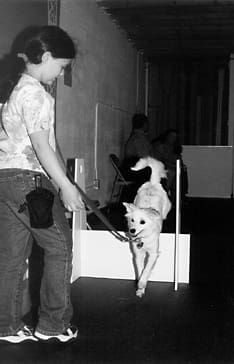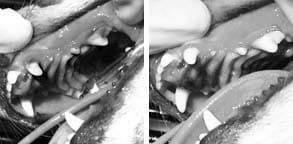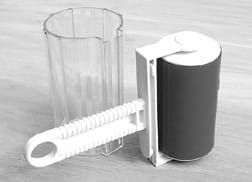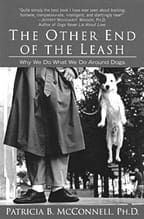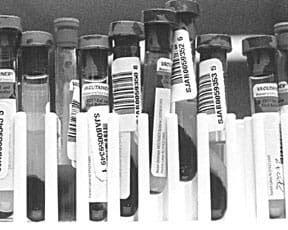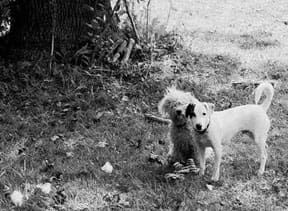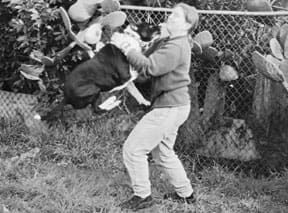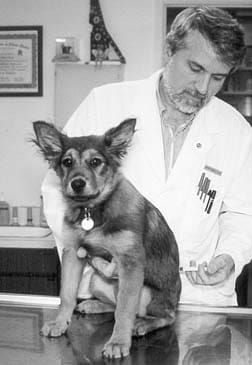[Updated February 5, 2019]
When Dusty, our elderly Pomeranian, comes in for his dinner, his tiny feet (slower now than they once were) do a little tap-dance in anticipation of his forthcoming food bowl. I get down on my hands and knees and play patty-paws with the 14-year-old – a game we have shared since he was a youngster. His eyes light up, he tucks his tail and he races gleefully around the room in a mad rush. I smile to see my aging pal’s inner puppy emerge, and reassure myself that there’s a lot of life still left in the furry old guy.
Playing does that. It reminds you – and your dog – of the joys in life; it makes your eyes light up and your tail tuck with glee; it keeps both of you active and young; and it strengthens that all-important bond that is so critical to your lifelong relationship.

Finally, play, and the resulting “feel good” mental response that comes with it, can add an important element of fun to your training program. If training isn’t fun for you and your dog, one or both of you will lose interest, and the end result will be that the program – and the relationship – are both at risk for failure.
Playtime for Dogs 101
Different dogs have different play styles. If I tried to play patty-paws with our Australian Kelpie, she would slink away in horror. Her idea of a rousing good time is to help me bring the horses in for their evening grain. Our Cattle Dog mix, Tucker, would rather fetch a stick or a tennis ball, or go jump in the neighbor’s pond. Our Scottish Terrier’s response to the paws activity would be a bored “Whatever . . . ” but he’d be delighted to engage in a game of “Let’s roust critters out of the drainage pipe!”
If you want to play with your dog, it’s important to understand his personal play style. Some dogs are happy to engage in a variety of games, others are pretty well fixed on just one or two. Let’s look at several different play styles, the dos and don’ts for each and some tips to help you determine the best way to play with your dog.
People-Oriented Play
These are games for dogs like Dusty, who want to engage with you. The toy, working, herding, and sporting dogs, bred to have close relationships with humans, are high on the list of people-oriented players. Chase, hide-and-seek, and tug of war are great games for people-oriented dogs.
Be sure and establish clear cues and rules for these games; they have the potential to be problematic if you don’t communicate well. You can be a little physical, as long as the dog doesn’t get “mouthy” or use the game as an excuse for body-slamming. Keep your physical contact at a low enough level that it doesn’t elicit aggressive responses. If your dog puts his mouth on your skin or clothing, you should immediately but cheerfully exclaim, “Oops!” or “Too Bad!,” and end the game.
One of Tucker’s favorite people-games is what my husband and I affectionately call “Growly butt scratch.” As the name implies, Tucker gets quite vocal when his rump is scratched, and will even swing his head around and bump his nose on your hand. He never bites, and his growl is a play growl. Nonetheless, this can startle unsuspecting visitors when they innocently reach down to scratch his offered hindquarters! If your dog has any similar games, it’s a good idea to pre-warn visitors.
Note: Some dog owners make the mistake of getting physical with a dog’s head – grabbing the cheeks, pushing and slapping at the face, and encouraging the dog to growl and bite back. This is a very bad idea, because it may encourage the dog to react aggressively when someone reaches for them – a response that could get them in serious trouble if someone misreads their intent even though they are “just” being playfully aggressive. The line between play aggression and real aggression can be fairly blurry, and if the dog crosses over the line to serious aggression, he’s in even deeper trouble.
Object-Oriented Play
These are activities for dogs whose idea of a really good time is to fetch a tennis ball, plush toy, or stick until they keel over from exhaustion. Lots of these dogs will also play with objects with other dogs, teasing a canine pal into a blood-pumping game of “Neener-Neener, I’ve Got the Toy,” which can morph into a canine version of tug of war when the teasee catches up to the teaser.
Some object-oriented dogs will even play by themselves, tossing a toy into the air and chasing or catching it, over and over. I know of at least one industrious Border Collie (and I’m sure there are more) who entertains herself by carrying a tennis ball to the head of a flight of stairs and pushing it off so she can chase it down the stairs and carry it back up, again and again.
Many of the herding, working, and sporting breeds are fond of object-oriented play. Games you can play with these dogs include fetch, find it, tug of war, and put it away. Be careful with this group; they sometimes don’t know when to quit. I had to carry my first Australian Kelpie back to the car on two different occasions – both long hikes – before I realized I had to stop throwing her ball for her when I thought she’d had enough; she would never stop on her own.
Speaking of stop, it’s a good idea to teach your object player an “All done!” cue, or they may bug you mercilessly to keep playing. I do that by saying “All done!,” and putting the ball immediately and firmly away in a closet or drawer.
Task-Oriented Play
These games are for dogs who need to do something meaningful. Terriers are great at this kind of play, as are the herding breeds, many of the working breeds, and some of the hounds. These dogs tend to take their play seriously; once engaged, it can be hard to turn them off.
Terriers can get quite excited about games like “dig it” and “let’s look for a small rodent.” They also excel at complex behavior tricks. The scent hounds, of course, are virtuosos at “find it”; they are limited only by your creativity. Herding dogs top the class at puzzle-solving and anything that resembles herding.
It’s easy to get caught up in the task-oriented dog’s intensity about their “jobs.” When you are using tasks as play, be sure to remember to keep it fun!
You’ve probably noticed that there’s a fair amount of overlap among these groups. Since our goal is to play with our dogs, we want all our games to be “people play,” at least to some degree. “Object play” often spills over into “task play.” In fact, while your dog may have a preferred play style, lots of dogs are perfectly willing to play whatever game you offer. You may have to help your dog develop his play skills in his non-native style, but he may surprise you with his heretofore hidden play talents.
Teaching Playfulness to a Dog
One of the saddest things about a dog who has never had a real relationship with humans is he may not know how to play. Backyard dogs and dogs who are institutionalized from early in life (puppy mill and poorly socialized kennel breeders, dogs who grow up in shelters without adequate stimulation) may not have had the opportunity to learn how to engage playfully with people. Many of them don’t even know how to play with other dogs! In fact, if you try to play with a dog like this you are more likely to scare him. You think you are acting playful and silly, but he just sees you as a human acting weird, and weird equals dangerous.
How do you teach a dog to play? If you’re starting with a new pup, you’re lucky; with puppies, it’s pretty easy. Puppies are born to play! When they do silly, puppy things (non-destructive, non-dangerous behaviors that don’t undermine your good manners training), reward and reinforce them. Instead of always quashing your baby dog’s puppyness, direct it into acceptable outlets and encourage it.
For example, rather than reprimanding your pup for picking up stuff in his mouth, puppy-proof your house, and encourage him to include you when he plays with his toys. If he manages to pick up a forbidden object, invite him to bring it to you, praise him, and trade it for a treat. Bingo! You’ll have a pup who brings things to you. Don’t worry about making him give you the toy; if you get grabby he’ll learn to play keep-away – not a good game! Instead, trade him for a treat, or a toy of equal or greater value.
Starting from early on, show him a toy, hide it in plain view and tell him to “find it!” As he gets the idea, hide the toy in less obvious places. Teach him to find your hiding kids and you’ll have a game the whole family can play, as well as a useful skill in case your kids, heaven forbid, should ever go missing.
When his behavior suggests an undesirable game he’d like to play, figure out how to direct it into a more acceptable activity. Is he digging holes in the backyard? Build him a digging box, bury his toys and bones, and help him dig them up. Eventually you can add a “dig it!” cue and teach him to dig at whatever spot you indicate.
Games for Adolescent Dogs
If you’re starting with an adolescent canine companion, you still have plenty of puppy energy to play with, although you may have to work a little harder to get him to play with you, now that he’s discovered the rest of the world. Start with games that appeal to him.
If he won’t chase things that you throw for him (balls, sticks, etc.), start by tossing yummy, high-value treats, one at a time. Toss one to your right, then one to your left, so he has to come back toward you each time.
When he realizes that delectable yummies are flying from your fingers and is enthusiastically pursuing the tossed goodies, add a cue before you launch, like “Get it!” Remember, you are playing, so any cues you use should be uttered in cheerful, we’re-having-a-wonderful-time play voice. The length of time you play each session will depend on your dog. Always stop while he is eagerly participating, before his interest and enthusiasm flags.
The next step is to stuff a yummy treat in a treat-holding toy, such as a Kong or Goodie Gripper toy, available from most pet supply stores and catalogs. Show your dog the toy with the treat in it, and toss it a very short distance. Let him get the treats out of the holes, then show him another food-stuffed toy, and toss it a short distance, so he leaves the one he has for the fresh one. Remember to keep it fun, with lots of happy praise.
While he is emptying the new toy, retrieve the first one, and stuff it again. When he’s ready, toss it a short distance. Keep swapping, restuffing, and tossing toys. When it’s clear that your dog enjoys this game, add your cue. As he gets good at running after the stuffed toy for short tosses, gradually increase the distance of your tosses. Chances are he will start bringing the first toy at least part of the way back to you, for which, of course, you will tell him he is absolutely brilliant and wonderful.
From there, your dog should be well sold on the fetch game, and can graduate to non-treat toys.
Stodgy Adult Dog Doesn’t Like to Play?
With seemingly non-playful adult dogs, follow the same, gradual steps for teaching play. Look for behaviors that lend themselves to games, and reward and reinforce your dog any time he does them. Encourage puppy-like behavior. Start small, and don’t overwhelm him. If your dog is intimidated by large displays of enthusiasm, keep your reinforcements small but sincere.
For the greatest success, remember to reward your dog with something that he loves. If you do it well, eventually the game will become its own reward. Then you’ll have a wonderful training tool that will allow you to reduce your dependence on food rewards.
For example, if your dog has learned to love playing tug, whip out your tug toy after a great stretch of heeling, and play the game as his reward. If he’s a tennis ball nut, throw his ball as his reward for a super recall, or for a dynamite distance down. Suddenly your entire training program becomes a game!
If you aren’t letting your inner child out to play on a regular basis with your dog’s inner puppy, you’re missing out on one of the greatest joys of sharing your life with a canine companion.
Games You Should NOT Play With Your Dog
A few canine games have high potential for reinforcing undesirable behaviors. While some dogs manage to play these games without apparent ill effect, the risks are great enough that we strongly suggest you avoid them, and thus avoid the risks altogether. After-the-fact behavior modification may be time-intensive and ineffective. Here are a few games we suggest you and your dog pass on:
■ Rough physical games. In addition to the notrecommended face-grab game (described in the text above), some owners like their dogs to get very physical in play, encouraging behavior such as mutual body-slamming and jumping up on humans. The problem is, it’s very difficult for a dog to distinguish between ready-andable play partners and frail and frightened ones.
It’s best to redirect high-contact physical activities to acceptable games such as tug of war (with rules). If you must teach your dog to jump up on you, or into your arms (we’ll admit this trick is cute), be sure to teach her that she can do it only when you give her some obscure verbal cue or hand signal that your grandmother is never likely to accidentally exhibit.
■ Chasing laser lights.It is entertaining to watch a dog chase a laser light beam with frenetic intensity, but BEWARE! The dog who most delights in chasing a laser light is the very dog who is most likely to turn the game into an obsessive/compulsive behavior known as shadow chasing. Shadow-chasers become fixated on any movement of light, and compulsively chase any light, reflections, or shadows that happen to cross their vision.
Obsessive/compulsive behaviors are frightening in their intensity, and difficult to resolve once they occur. Be smart and avoid this game – and any others that elicit intense, compulsive responses.
■ High-energy indoor games. In general, indoor games should consist of activities that require the dog to use his brain, not his brawn. Games that involve mad dashes around furniture, bouncing soccer balls off noses, and burrowing for hidden treasures, are best suited for the great outdoors – not just because they can cause damage to family heirlooms, but also because, in general, encouraging your dog to be calm and self-controlled inside the house is a better idea.
If you live in an apartment with no yard and the only way to exercise your high-energy dog is with indoor play, keep the games very structured. For example, roll a ball down stairs or a hallway, don’t throw it; require your dog to “Wait!” before you release her to pursue the prey; and have her sit and politely drop the ball into your hand when she brings it back. Ask for another “Wait!” before you roll it again. Practice some “moving downs” while she is on her way to the ball, and on her way back.
PLAYING WITH YOUR DOG: OVERVIEW
1. If you don’t already know how your dog likes to play, observe him to figure out how you can best arouse his interest. Select games that are likely to appeal to his natural play style.
2. If your dog has any tendency toward an obsessive/compulsive disorder (OCD), cancel any game that triggers his obsession. For example, chasing a laser light has set many a predisposed dog on the path to OCD.
Pat Miller, WDJ’s Training Editor, is a Certified Pet Dog Trainer, and president of the Board of Directors of the Association of Pet Dog Trainers. She is also the author of The Power of Positive Dog Training and Positive Perspectives: Love Your Dog, Train Your Dog.


